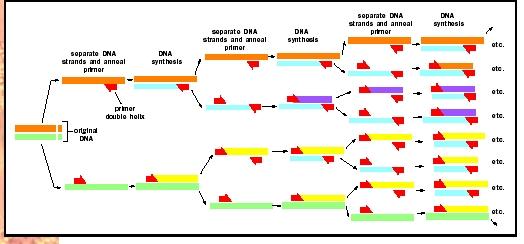Polymerase Chain Reaction
The polymerase chain reaction (PCR) is a process that allows one to make in a short amount of time many copies of a particular deoxyribonucleic acid (DNA) sequence. It was developed in 1985 by Kary Mullis and has provided scientists in diverse fields with a powerful tool for DNA amplification, analysis, and manipulation.
The technique involves repeated heating and cooling cycles and requires the DNA polymerase (known as Taq ) from the organism Thermus aquaticus ; these cycles are usually controlled by a machine known as a thermal cycler. Since high temperatures usually inactivate most enzymes , the DNA polymerase used in this procedure is isolated from a heat-tolerant bacterium.
The high temperature (90 to 92 degrees Celsius [194 to 197 degrees Fahrenheit]) disrupts the hydrogen bonds between the bases of DNA and results in the separation of the two DNA strands. Since all enzymes that duplicate DNA require short sequences known as primers , the priming sequences for the desired region are added and the temperature is then lowered. The primers anneal with sequences on each strand of the DNA, and Taq then uses added nucleotides to synthesize a new strand of DNA that is attached to the primers and complementary to each of the original strands.
The sample is then heated again to separate the strands and liberate the primer, and the sample is again cooled to allow another round of DNA duplication. Each round takes only a few minutes, and double the number of DNA strands each time. The process is repeated many more times with the

While early PCR techniques were limited to copying up to 1,000 base pairs , methods developed in the late 1990s have extended the limit up to 10,000 base pairs or more. The procedure will copy any DNA molecule and, consequently, the scientist must make certain that no extraneous DNA is present in the reaction tube.
PCR has allowed people to produce large amounts of DNA from a variety of sources: blood or semen from a crime scene; single embryonic cells for prenatal diagnosis; frozen ancient mammals; cells infected with viruses such as HIV (human immunodeficiency virus).
SEE ALSO Archaea ; Clone ; DNA Sequencing ; Forensic DNA Analysis ; Replication
William R. Wellnitz
Bibliography
Campbell, Neil A., Jane B. Reece, and Lawrence G. Mitchell. Biology, 5th ed. Menlo Park, CA: Benjamin Cummings, 1999.